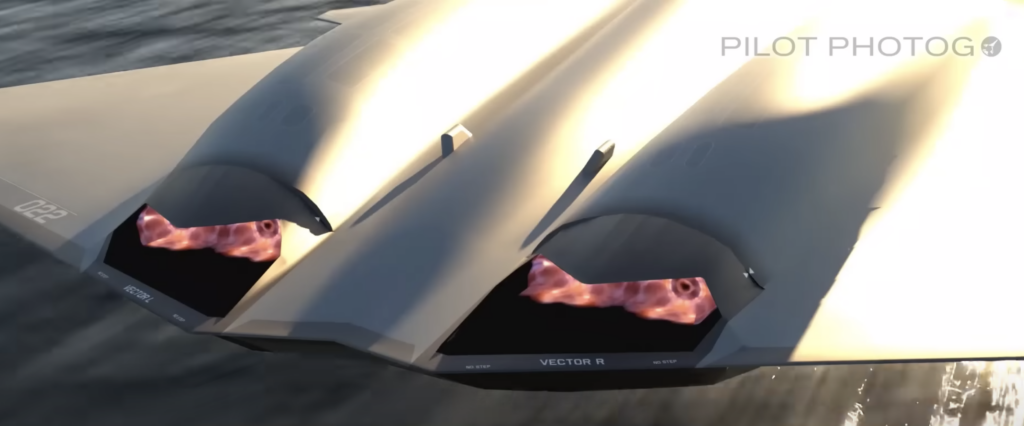Youtuber Pilot Photog has renderings of the likely look of the US Navy’s planned F/A-XX 6th generation stealth fighter. The reason Pilot Photog can be quite confident that the F/A-XX will look like this is that a blended wing body (BWB) design. The BWB is what will be used for the Air Force NGAD (Next Generation Air Domination) 6th generation fighter.
The BWB has more range and is better for stealth.
Other aspects are the need to get rid of the radar reflecting vertical tails and to hide the engine and other parts from radar reflection.
The BWB can still achieve supersonic speed.
The Navy F/A-XX must use shorter aircraft carrier runways while the Air Force NGAD can use long land based runways. This forces other Navy engine design changes.
The other 6th generation fighter designs from Japan-Italy and China do not have all of the US experience with Blended wing planes, flying wings and stealth. This is why most of the published designs for their planes include vertical tails. They cannot go for all of the maximum stealth options which the US is able to use.
The F/A-XX has been in development for 3 years and $1.53 billion has been allocated in 2024. This budget is more than the next gen submarine and next gen destroyer.





Brian Wang is a Futurist Thought Leader and a popular Science blogger with 1 million readers per month. His blog Nextbigfuture.com is ranked #1 Science News Blog. It covers many disruptive technology and trends including Space, Robotics, Artificial Intelligence, Medicine, Anti-aging Biotechnology, and Nanotechnology.
Known for identifying cutting edge technologies, he is currently a Co-Founder of a startup and fundraiser for high potential early-stage companies. He is the Head of Research for Allocations for deep technology investments and an Angel Investor at Space Angels.
A frequent speaker at corporations, he has been a TEDx speaker, a Singularity University speaker and guest at numerous interviews for radio and podcasts. He is open to public speaking and advising engagements.


The ngad project will be sharing technology Systems with the international British led Tempest, sixth generation Project. This makes sense, since they are all part of Nato. This will also Accelerate the tempest project, which is several years behind the ngad.
The paradigm is likely to change during the next potential war. In WW1, it was about trench warfare and the tank appeared, and altered the conflict dramatically. In WW2, battleships were expected to be decisive, but air power, delivered via aircraft carriers was the decisive paradigm shift that changed WW2.
In WW3, while the US spends a fortune to fortify the carrier, by surrounding it with carrier strike groups, while it is obvious that inexpensive drones, both by sea and air, will deny carrier strike groups the ability to put pressure on an opponent. Moreover, inexpensive subsea drones where they can attack en mass, will destroy carrier strike groups, particularly where an enemy can overwhelm the fleets defensive capabilities.
Drones, subsea, surface, and air should be used to build a virtual wall around the fleet. Simultaneously, offensive drones, should be used, forward of the fleet, to destroy enemy missile, and drone, launchers. These offensive drones should be able to have their numbers rapidly augmented by forward deployed stealth aircraft. I’d envision aircraft releasing thermal drones instead of flares. I’d envision these “flocks” of drones attacking, much as the way starlings do in their unique flocks, called mumurations. Such formations could be used defensively and offensively. Imagine swarming enemy airfields, and missile sites, much as angry bees swarm their targets.
To the country that is capable of such outside the box thinking, comes victory. Adaptation does not come easily to politicians who masquerade as generals and admirals. The country that can develop fleets of 100’s of thousands of these microdrones, and the necessary supporting infrastructure will likely be victorious in WW3.
Tailless design is from the b2 grandaddy bomber.
They can’t even keep the F35’s running effectively. What makes anyone think they will be any better with this plane?
The USAF is pursuing their own F/X design that will likely incorporate many of the same features and technologies of the Naval fighter. But the USN has different needs and the F/A will work in a “Hi/Low” scenario with the F35 and the waning years of the Super Hornet.
Where does this fit with the F35? I thought this next gen fighter was supposed to be a pure replacement for the F22 and solely air-air, so whats with the F/A designation? What does the navy want with it?
NGAD is the F-22 replacement. This is the Navy’s version. You are getting the Navy version and Air Force mixed up.
Blended wing + adaptive cycle engines enables ranges that are, frankly, ludicrous. So long as the design compromises to accomdate something like the B-61 in an internal bay are minimal, adding a deep strike role is reasonable IMO.
GreenPlease is accurate in his reply.
Also, whereas the USAF NGAD is a replacement for F-22 in the air-dominance role, I don’t think the USN ever had a similar line of thinking for its 6th gen a/C. Hence the designation of “F/A-“.
Gone are the days of the Tomcat or Sprey’s “not a pound for air to ground”. Stealth is expensive, so having 1 platform be able to do both air-to-air and strike is probably more cost effective.
Development cycles of decades. Ford starts working on the next vehicle design before they start selling the current model year. The long term projects go out decades. For the government they go out many decades. And under immense shush shush.